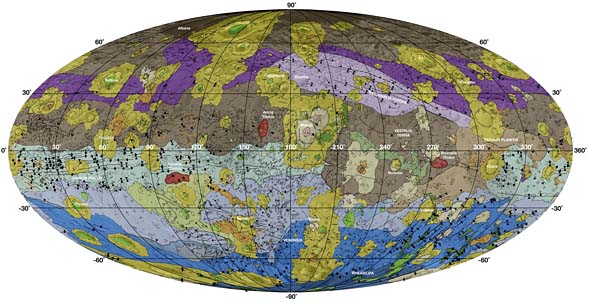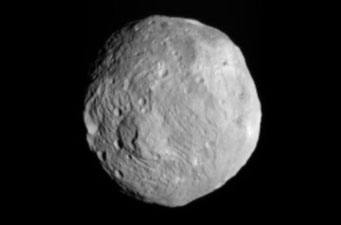NASA's Dawn spacecraft spent 14 months photographing Vesta from close range. Now researchers have completed a global map of the asteroid's surface geology.
Planetary geologists are always seeking to know the sequence of events that shaped a solar-system body, and now they have a much better idea of what happened when on asteroid 4 Vesta. A detailed geologic map, published in the December issue of Icarus, shows features large and small revealed by NASA's Dawn spacecraft during its 14-month-long survey of Vesta in 2011-12. It represents 2½ years of effort by David A. Williams (Arizona State University), R. Aileen Yingst (Planetary Science Institute), and 12 others.
Shown below, the global map reveals that this oblong, 573-by-446-km body is divided into provinces pegged to the formation of its three largest craters. Roughly a third of Vesta's surface (shown as brown and tan hues) comprises old, heavily cratered areas in the northern hemisphere. These predate the excavation of a huge basin, 400-km-wide Veneneia, near Vesta's south pole.

D. A. Williams & others / Icarus
A wide northern band (shown in purple) represents terrain emplaced after Veneneia but before the formation nearby of Rheasilvia, which is even larger — half the diameter of Vesta itself. Ejecta from that blast are shown in blue hues. A final veneer (yellow-greens) followed the formation of Marcia crater, 68 km wide and one of the asteroid's youngest features.
Vesta also exhibits clusters of ridges and troughs, which are depicted in the map as black lines. A cluster in the northern hemisphere, named Saturnalia Fossae, likely resulted from internal stresses during the impact event that formed Veneneia. An even denser set, called Divalia Fossae, extends east-west right along the equator and seems to be associated with Rheasilvia.
Getting the Timetable Right
It's the "when" part of Vesta's history that's given Williams and his colleagues trouble. They deduce one set of ages when using a model based on an assumed cratering rate within the asteroid belt — and very different ages when attempting to extrapolate from cratering rates on the Moon and from the ages of lunar samples.

NASA / JPL
For example, the Veneneia blast occurred either about 2.1 or 2.7 billion years ago, according to the asteroid or lunar model, respectively. Likewise, Rheasilvia could have been excavated as recently as 1.0 billion years ago (asteroid model) or as long as 3.5 billion years (lunar model). Adding to the confusion, the asteroid model implies a significantly older age for Marcia (about 390 million years) than does the lunar model (120 million years).
Just as lunar samples returned by Apollo missions removed uncertainty regarding the Moon's age, in principle geochemists would be able to accurately date Vesta if they could only get their hands on samples of its surface. And, incredibly, they can! Three closely-related basaltic meteorite groups known as howardites, eucrites, and diogenites (HEDs) are such close spectral matches to Vesta that the big asteroid (most likely the Rheasilvia basin) must have been their launch site.
But laboratory tests suggest that these "Vestoids" have very old ages, dating to at least 4 billion years ago. These correspond to when the rocks solidified from a basaltic magma. Big cratering events on the Moon create such powerful shock waves that the target rocks' isotopic clocks get reset. But apparently that didn't happen on Vesta, because collision speeds among asteroids are generally much lower, no more than about 5 km per second.
Consequently, while the mappers can tell which impacts came first and which ones later, in a relative sense, they're unable to pin down when specific events occurred. Perhaps the surface of even larger 1 Ceres, which Dawn will reach in early March 2015, holds additional clues to the ages of asteroids' surfaces.
Read about Dawn's amazing adventures around Vesta in Sky & Telescope's November 2011 issue
 5
5
Comments
Anthony Barreiro
December 9, 2014 at 3:39 pm
Thanks Kelly. This is fascinating. A wealth of data from Dawn, and excellent analytic work by Williams, Yingst, et al. Are there any plans for a robotic sample return mission to Vesta?
You must be logged in to post a comment.
December 10, 2014 at 10:17 am
Anthony, to answer your question, no, there aren't any plans for a sample return mission to Vesta. And given NASA's funding situation for planetary sciences, there isn't likely to be one for a VERY long time. However, mother nature has been kind enough to do the work for us: the impacts that created Vesta's overlapping polar basins hurled huge amounts of material into independent solar orbits. Some of the larger chunks are Vesta family asteroids while some of the smaller chunks have made their way to Earth as HED ( Howardite-Eucrite-Diogenite) meteorites which science has been studying for decades now with the results from Dawn firmly establishing Vesta as their place of origin.
You must be logged in to post a comment.
Anthony Barreiro
December 10, 2014 at 3:40 pm
Would there be any advantage to getting samples directly from the surface of Vesta, rather than from meteorites that were created by catastrophic impacts, hurled into space, char-broiled hurtling through Earth's atmosphere, and exposed to water, oxygen, etc. here on Earth?
You must be logged in to post a comment.
December 10, 2014 at 7:16 pm
As any geologist will tell you, there is always an advantage to knowing exactly where a sample came from and its geologic context. And the more pristine the sample, the better. However, the prospects of getting a sample return mission to any asteroid belt members are very dim for the foreseeable future. Just to provide context, there has been talk of sending spacecraft to the largest asteroids for well over a third of a century. I remember studies in the late 1970s for a possible American flyby of Ceres in the 1980s and a few years later, talk of a Soviet flyby of Vesta. Vesta wasn't finally reached until 2011 and we're due to reach Ceres in a few months... decades after we could have or thought we would have a third of a century ago.
http://www.drewexmachina.com/2014/11/27/the-future-that-never-came-planetary-missions-of-the-1980s/
Given this track record, we are likely decades away from a Vesta sample return. There are scientifically and politically higher priority targets out there vying for a shrinking pool of funding than an main belt asteroid sample return mission.
You must be logged in to post a comment.
Anthony Barreiro
December 10, 2014 at 8:21 pm
Thanks Drew. Maybe it would make more sense to send a lander with an onboard geochemistry lab, like the Mars landers. Rather than bringing the rocks to a lab, send a lab to the rocks. 😉
You must be logged in to post a comment.
You must be logged in to post a comment.